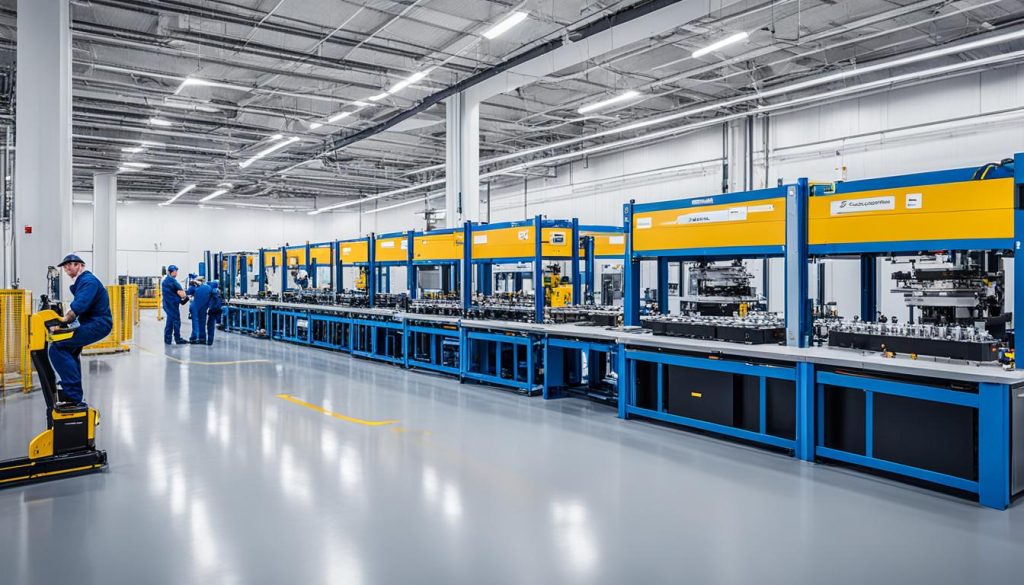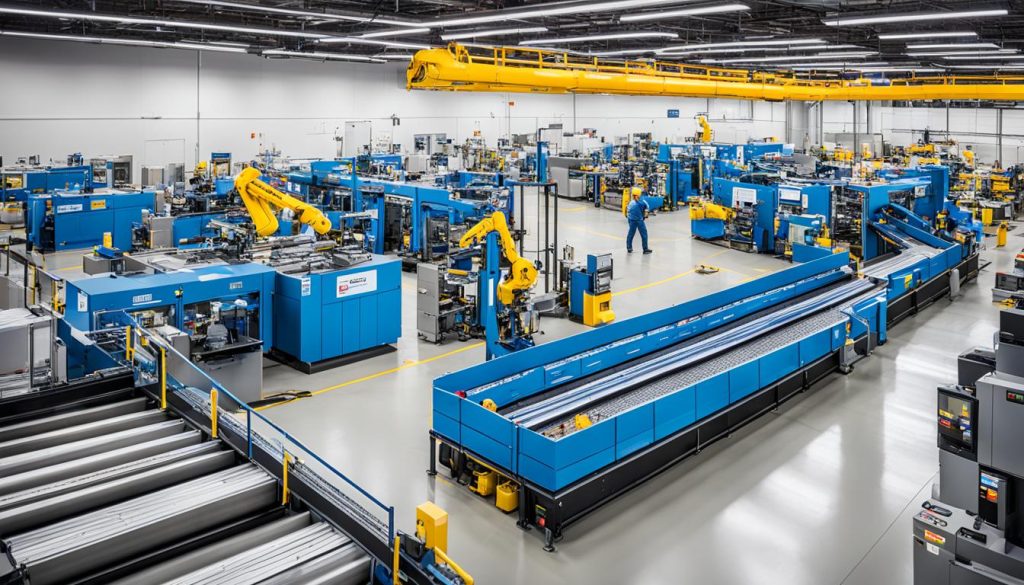As you navigate through the dynamic realm of manufacturing, it’s invigorating to witness how certain enterprises have etched remarkable success stories into the industry’s fabric. These manufacturing industry case studies are not just narratives; they are a testament to the strategic acumen and relentless pursuit of excellence that drives the sector. Through examining successful manufacturing projects, you gain invaluable insights into how businesses catapult from mere contenders to industry pioneers.
Dive into a series of manufacturing case studies for success that unveil the amalgamation of innovation, adaptability, and foresight. Each saga is laden with lessons on overcoming operational hurdles, and these manufacturing success stories echo the resilience and transformative power inherent within today’s manufacturing landscape.
Key Takeaways
- Discover the strategies that led to breakthroughs in the manufacturing sector.
- Learn from real-world examples of businesses confronting and conquering challenges.
- Find inspiration in the stories of manufacturers who innovated and redefined industry standards.
- Gain knowledge of the pivotal factors contributing to triumphant manufacturing endeavors.
- Understand the importance of adaptability in overcoming manufacturing complexities.
Exploring the Impact of Innovation on Manufacturing
The relentless pursuit of innovation within the manufacturing industry has not only led to increased efficiency and productivity but also paved the way for a new era of industrial case studies. Below, we delve into multiple facets of this evolution, highlighting how various companies have embraced technological advancements to revolutionize their manufacturing processes.
Navigating the Road to Automation
In the domain of automotive manufacturing, General Motors stands as a sterling example of automation. By integrating robotics and artificial intelligence, they enhanced their assembly line, bringing forth a significant uptick in output while reducing human error. Case study examples in manufacturing like this underscore the breadth of possibilities that automation introduces to the industry.
Adopting Sustainable Manufacturing Practices
Sustainability has become more than a buzzword in the realm of production; it’s a necessary evolution. Companies like Patagonia have championed the charge, showcasing that eco-friendly manufacturing practices can coexist with profitability—a testament to the feasibility of a greener industrial future detailed in numerous industrial case studies.
Revolutionizing Production with 3D Printing
Aerospace giant Boeing has leveraged 3D printing to manufacture parts for its aircraft, significantly cutting down production times and costs. This technological leap is not just a benchmark in manufacturing examples but a glimpse into a future where complex constructs can be crafted with remarkable precision and speed.
| Innovation | Company | Impact |
|---|---|---|
| Automation with AI & Robotics | General Motors | Enhanced efficiency, reduced errors |
| Sustainable Practices | Patagonia | Reduced environmental impact, sustainable growth |
| 3D Printing | Boeing | Streamlined production, reduced lead times |
Each case presented above showcases how embracing innovation is not merely a trend but a strategic approach to securing a competitive edge and fostering long-term success. By exploring these case study examples in manufacturing, you’re witnessing the blueprint of the industrial future taking shape.
Transformative Manufacturing Technologies in Action
As you delve into the world of manufacturing business success, it becomes apparent that the evolution of technology plays a pivotal role. In particular, innovative technologies have a profound impact on industrial case studies, showcasing significant advancements in efficiency and competitivity. The following examples throw light on how modern tools and approaches are redefining manufacturing operations.
Robotics and automation, for instance, are no longer futuristic concepts but tangible realities driving businesses forward. In an effort to optimize productivity, companies are increasingly relying on these technologies to perform repetitive, labor-intensive tasks with precision.
- Automated assembly lines
- Advanced robotics in materials handling
- Integration of Artificial Intelligence for predictive maintenance
These measures not only improve throughput but also enhance the safety of the work environment by reducing the need for human workers to perform risky operations.
Another transformative leap forward is the integration of Internet of Things (IoT) in manufacturing processes. IoT devices collect and analyze data in real-time, offering insights that lead to smarter decision-making and predictive analytics.
Consider the case study of a prominent auto-parts manufacturer who adopted IoT. Sensors were installed on machinery to remotely monitor performance and notify technicians before a potential failure could cause downtime. This proactive approach illustrates how IoT keeps operations running smoothly and efficiently.
Here’s a snapshot that captures the comparative advantages brought by these technologies:
| Technology | Benefits | Example of Improvement |
|---|---|---|
| Robotics and Automation | Improved efficiency and safety | 50% reduction in assembly time for an electronics manufacturer |
| IoT Devices | Real-time data and predictive maintenance | 30% decrease in unplanned downtime for an auto-parts manufacturer |
Finally, the journey toward manufacturing excellence is punctuated by the adoption of additive manufacturing or 3D printing. This technique has revolutionized prototyping, allowing for rapid iteration and innovation, and is now even used in production of end-use parts.
For example, a leading aerospace company employed 3D printing to produce lightweight engine parts, resulting in significant savings in both material costs and fuel consumption. Such industrial case studies underscore the agility and creativity fueled by additive manufacturing.
By embracing transformative technologies, manufacturers are not only enhancing their operational capabilities but are also carving a niche for themselves in the global marketplace.
As you can see, these technologies have been instrumental in bolstering manufacturing business success, confirming that the future belongs to those who innovate and adapt.
Evolution of Efficiency: Streamlining Operations
In the competitive landscape of the manufacturing industry, efficiency isn’t just an advantage; it’s a necessity for staying ahead. Companies that adopt streamlined operational models not only see a reduction in resource wastage but often enjoy a surge in productivity and profitability. This section examines real-world applications of efficiency principles and practices within the manufacturing sector.

Lean Manufacturing Principles at Work
Lean manufacturing principles have been the cornerstone of efficiency for many successful manufacturing projects. Toyota, for instance, is often acclaimed for its Toyota Production System (TPS), which is a paragon of lean manufacturing. TPS focuses on the continuous elimination of waste and aims for the most efficient production approach with what is known as ‘Just-in-Time’ production. These principles aren’t reserved for the automotive industry alone; they’ve been successfully applied across a myriad of sectors, showing that lean manufacturing is a broad-reaching success story.
Case Analysis: Just-In-Time Inventory Successes
Implementing a Just-In-Time (JIT) inventory system can dramatically reduce costs and increase workflow efficiency. JIT, a strategy that aligns raw-material orders from suppliers directly with production schedules, is highly dependent on precise timing and, when executed correctly, can significantly minimize inventory sizes and consequent holding costs.
Let’s look at some key players:
| Company | Industry | Outcome with JIT |
|---|---|---|
| Harley-Davidson | Automotive | Remarkable turnaround from excess inventory costs |
| Dell | Technology | Revolutionized PC manufacturing logistics |
| Nike | Retail & Apparel | Enhanced market responsiveness and reduced overproduction |
Harley-Davidson’s implementation of JIT allowed the company to rectify its bloated inventory issues, transforming it into a model of manufacturing efficiency. Dell’s direct-to-customer model is another prime example of JIT’s successful application, radically altering the landscape of PC manufacturing and sales. Similarly, Nike’s JIT strategy enabled it to produce closer to the consumer, resulting in fewer unsold items and more flexibility to respond to market demands.
The narratives of these manufacturing success stories elucidate a clear trend: integrating lean practices and JIT inventory systems are not just beneficial strategies, they are cornerstones of modern operational success in manufacturing. As these manufacturing industry case studies showcase, investing in efficiency is a testament to a company’s commitment to continuous improvement and adaptability in an ever-evolving sector.
Modernizing Legacy Systems for Contemporary Success

The manufacturing sector thrives on innovation, and the modernization of legacy systems is a testament to this fact. Many companies are successfully navigating the delicate process of updating old machineries and practices, a crucial step in staying relevant in today’s fast-paced market. As you explore recent case study examples in manufacturing, you’ll notice a recurring theme of improved performance, better product quality, and increased customer satisfaction post modernization. Let’s delve into real-life examples that highlight the importance of adaptation in the manufacturing industry.
One of the notable manufacturing case studies for success is seen in the automotive industry. Legacy equipment that once served well in the production of vehicles were replaced with advanced robotics, and the result was nothing short of transformative. Beyond achieving heightened efficiency, these changes also brought forth a significant reduction in production costs and increased safety for workers.
“Upgrading to automated systems was a game-changer for our manufacturing line. It not only sped up our assembly process but also reduced the margin of error to nearly zero.” – CEO of an award-winning automotive company
When it comes to modernizing manufacturing systems, digital solutions have played a crucial role. The implementation of Enterprise Resource Planning (ERP) software has streamlined operations from inventory management to customer relations. By replacing outdated manual processes with sophisticated tech, manufacturers have seen a renaissance in the way they operate and serve their clients.
- Enhanced tracking of inventory levels
- Real-time data analysis for decision making
- Improved supply chain management
- Increased transparency across departments
These success stories serve as a roadmap for other companies contending with the dilemma of whether to renovate their own outdated systems. Embracing the shift towards modernization is not merely an option but a necessity to retain competitive edge and customer satisfaction in the dynamic landscape of manufacturing.
Success Stories of Smart Factory Implementations
The industrial landscape is undergoing a significant transformation as cutting-edge technologies redefine manufacturing processes. In this exploration of modernized production, we focus on how smart factory implementations are contributing to manufacturing business success and creating benchmarks in industrial case studies. Let’s delve into real-world examples where technology like IoT and AI is not just an addition but the backbone of smarter manufacturing.
Integrating IoT for Smarter Production
Manufacturers are increasingly turning to the Internet of Things (IoT) to gain a competitive edge. With IoT integration, companies like Siemens and General Electric have seen remarkable improvements in their production lines. This interconnectedness has led to predictive maintenance, optimized energy usage, and enhanced operational efficiency, which are pivotal factors in achieving a lean and agile manufacturing process.
For instance, GE’s Brilliant Manufacturing Suite has enabled factories to optimize production scheduling and reduce equipment downtime. By utilizing IoT sensors and advanced analytics, these factories are tracking real-time performance and anticipating maintenance needs before they become costly problems.
How AI is Reshaping Quality Control
Artificial Intelligence (AI) is another frontier in the quest for manufacturing excellence. Quality control, a critical aspect of industrial operations, has seen a substantial technological uplift. AI algorithms can now detect defects and inconsistencies with a precision that far surpasses human capabilities. This not only reduces waste but also ensures that the end products meet the highest standards.
A distinct example is the collaboration between NVIDIA’s AI platforms and KUKA Robotics, which demonstrates how AI brings quality control into the future. AI’s image recognition and machine learning have been employed to inspect parts with a speed and accuracy that significantly reduces the margin for error and enhances overall product quality.
The bottom line for manufacturers embracing smart technologies is clear: investment in IoT and AI not only brings about immediate operational efficiencies but also lays the foundation for sustainable growth and a strong competitive stance in the marketplace.
The Global Landscape: Diverse Manufacturing Case Studies
As we broaden our horizon to a global scale, your understanding of manufacturing success extends beyond local markets. Throughout the world, manufacturers are navigating complex market dynamics, blending innovation with cultural insights to achieve enduring success. These case studies of manufacturing success are not mere stories; they are testaments to human ingenuity in the face of globalization’s demands.
Adapting to Market Changes: A Cross-Cultural Review
Your curiosity about how different cultures impact manufacturing practices will find satisfaction here. Companies globally have learned to pivot and adapt, incorporating local consumer behavior and market trends into their operations. The essence of these successful manufacturing projects lies in their capacity to respect and leverage cultural differences, turning potential obstacles into unique value propositions. These adaptations are not just about survival; they are about thriving in varied environments—highlighting the agility that defines modern manufacturing success stories.
Export Triumphs: Breaking into New Markets
Witnessing manufacturing entities venture into uncharted territories is a clear indicator of the sector’s competitive spirit and strategic acumen. Export triumphs are frequently at the heart of these case studies of manufacturing success. These narratives embody the bold steps and calculated risks taken by manufacturers to introduce their products to new markets. In doing so, they bridge geographical divides and earn global recognition, securing their foothold as industry leaders. Each successful venture underscores a lesson in both resilience and international business savvy, serving as inspiration to others seeking a blueprint for their own global expansion.
FAQ
What are some key factors that contribute to manufacturing success?
Key factors include the adoption of innovative technologies such as automation and AI, the implementation of sustainable practices, and the modernization of legacy systems. Embracing lean manufacturing principles and just-in-time inventory strategies also plays a critical role in enhancing efficiency and reducing waste.
How has automation transformed manufacturing businesses?
Automation has led to increased efficiency, accuracy, and productivity in manufacturing. By integrating robotics and AI, companies have been able to streamline processes, reduce manual labor, and minimize errors, leading to higher output and better quality control.
Can you provide examples of sustainable manufacturing practices?
Yes, sustainable practices include the use of renewable energy sources, waste reduction techniques, recycling and upcycling materials, and the designing of products for longevity. Companies investing in these areas are reducing their environmental footprint and often experiencing cost savings and enhanced brand reputation.
What role does 3D printing play in the manufacturing industry?
3D printing has revolutionized prototyping and production by allowing for rapid creation of complex and customized parts with minimal waste. This has enabled faster product development cycles, reduced costs for small production runs, and opened up possibilities for innovative product designs.
How have manufacturing technologies improved operational capabilities?
Manufacturing technologies such as the Internet of Things (IoT), big data analytics, and machine learning have improved operational capabilities by providing real-time insights, predictive maintenance, and enhanced decision-making. This has led to smarter production processes and improved product quality.
Can lean manufacturing and JIT inventory really impact the bottom line?
Absolutely. Lean manufacturing principles help companies to identify and eliminate waste, leading to a more efficient production process. Just-In-Time (JIT) inventory reduces the costs associated with storing excess inventory and minimizes the likelihood of production delays due to stock shortages, ultimately impacting the bottom line positively.
What are the challenges of modernizing legacy manufacturing systems?
Modernizing legacy systems often involves substantial investment in new technology and retraining of staff. Challenges include integrating new and old systems, managing downtime during the transition, and ensuring that the new procedures are adopted smoothly to negate resistance to change and ensure operational continuity.
How are smart factories changing the manufacturing landscape?
Smart factories utilize IoT, AI, and other advanced technologies to create interconnected systems that are self-monitoring and can automatically adjust processes. This results in enhanced efficiency, reduced production costs, and the ability to quickly respond to market demands and quality control issues.
What advantages do manufacturing companies gain by entering new markets?
By entering new markets, manufacturers can expand their customer base, diversify their product offerings, and spread their operational risk. Successful entry into new markets can also lead to increased revenue streams and opportunities for innovation through exposure to different market demands and consumer preferences.







